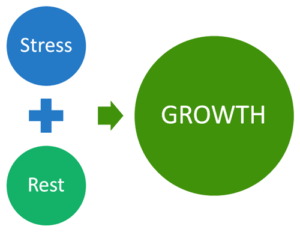Even as a semi-retired person, I’m always on the lookout for ways in which I can stimulate my body and mind to ever greater levels of excellence. Enter Brad Stulberg and Steve Magness’ book Peak Performance: Elevate Your Game, Avoid Burnout, and Thrive with the New Science of Success.
 Exercise science provides a model for GROWTH by alternating STRESS (challenging stimuli) with REST. Stress demands rest, and rest supports stress. Renowned psychologist Mihaly Csikszentmihalyi noted a similar dynamic in creative thinking. A period of intense, total engagement (immersion) followed by rest and recovery (incubation) leads to insight.
Exercise science provides a model for GROWTH by alternating STRESS (challenging stimuli) with REST. Stress demands rest, and rest supports stress. Renowned psychologist Mihaly Csikszentmihalyi noted a similar dynamic in creative thinking. A period of intense, total engagement (immersion) followed by rest and recovery (incubation) leads to insight.
So, what constitutes “good stress”?
We stimulate growth by giving ourselves manageable challenges and focusing on their mastery with total concentration. New skills arise in the context of struggle, but not too much (to the point of breakage) or too long (to the point of exhaustion). Furthermore, we must give their development our full attention. Our brains are not wired for multitasking. With each distraction from the primary task, our ability to filter out irrelevant information, identify patterns, and feed long-term memory declines. Consider “deep work” a practice to be cultivated over time.
We support our quest for continuous challenge with a growth mindset. With this frame of reference, we can’t wait to get out of the starting blocks. (“Let me at ’em!”) We welcome trials and tribulations as part of the process of gaining competency. We know that setbacks provide opportunities for learning and revising strategies. They do not shatter confidence in reaching toward the finish line.
Why does rest matter?
Athletes understand the need for rest. When their bodies have reached the break point, they back off to allow time for recovery. Rest prevents injury and supports muscle building. But since thinking does not create muscle strain, why take brain breaks?
While we certainly improve cognition through “exercise,” a skillful practice of meditation strengthens the mindfulness muscle – i.e., our capacity to be fully present in the moment. This “muscle” provides the means to view our thoughts and feelings from the perspective of a neutral observer and exercise choice in how we respond to stimulus. It helps us avoid getting hijacked by our reactive amygdala. Not surprisingly, a consistent practice of meditation gives rise to an increase in the size of the prefrontal cortex, the part of the brain that exercises attention, inhibits impulse behavior, and exercises control.
Good ideas often crop up when we’ve made space between periods of intense thought. In these intervals, the brain switches from its task-positive network (linear, logical, if-then) to its default mode (random, subconscious, integrative). In this mode, the brain can retrieve previously inaccessible bits of information and make connections between disparate data pulled from all parts of the brain. Though seemingly coming out of thin air, these insights spring forth from a brain that was always active in the background.
So, what does this mean?
Top tier athletes, thinkers, and other performers understand the need for challenge and rest. Every 60-90 minutes of deep work should be paired with 7-20 minutes of rest. The latter need not be a period of sloth. It can be filled with activities that require little to no effortful labor or thinking. For example:
- Take a short walk, preferably out in the fresh air (although indoor walking works in inclement weather). It’s heart and brain healthy!
- Look at pictures of nature. It stimulates the brain and lowers inflammation.
- Take a break with a friend or colleague with whom you can enjoy a light and pleasant social interaction. The resulting release of oxytocin will make you both feel better.
- Meditate in a relaxed setting.
- Take a 10 minute nap – just long enough to improve performance, alertness, concentration, and judgment, but not so long as to engender grogginess or disrupt nighttime sleep patterns.
In addition to periods of workday rest, stellar performance calls for extended breaks – e.g., observing a weekly day of rest, and taking regular 7-10 vacations without bringing work with you!